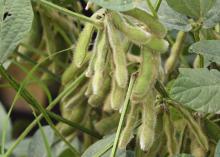Information Possibly Outdated
The information presented on this page was originally released on August 2, 2018. It may not be outdated, but please search our site for more current information. If you plan to quote or reference this information in a publication, please check with the Extension specialist or author before proceeding.
Soybean growers wait out trade war
STARKVILLE, Miss. -- Mississippi’s soybean crop is in good or excellent condition, but growers are losing access to some foreign markets due to circumstances beyond their control.
Earlier this year, President Donald Trump ordered tariffs on imported steel, aluminum, solar panels and washing machines -- all products China regularly exports to the U.S. In response, China enacted tariffs on U.S. goods effective July 6, including 25 percent levies on soybeans, wheat, corn and rice.
China’s trade leaders courted alternate supply sources, while growers and ag advocacy groups began voicing concerns about losing the Chinese market. Trump announced a $12 billion emergency aid package to help growers offset losses.
“There are a couple of sets of tariffs: One is the tariff we’ve placed on Chinese goods, and the other is the ones that China placed on our goods in retaliation,” said Josh Maples, an agricultural economist with the Mississippi State University Extension Service. “The tariff that China has placed on our soybeans makes U.S. soybeans more expensive to Chinese buyers and makes us less competitive with other soybean-exporting countries.”
Dr. Josh Maples discusses how trade negotiations between the U.S. and China are affecting Mississippi soybean growers.
Maples said Brazil stands to gain the most from the trade war on soybean exports.
“Our growing season is basically opposite from Brazil’s, so their planting season is just now coming up. They are already looking to plant more soybeans to take advantage of this increased opportunity that they’re going to have,” he said. “With this tariff, Brazilian soybeans are relatively less expensive than U.S. beans in China.”
Growers’ profit margins are already feeling the sting of the trade war, as evidenced by market prices for cash soybeans and futures. On July 31, cash soybeans were $8.98 per bushel in Greenville and $8.78 per bushel in Indianola. November soybean futures were trading at around $9.18 on the same day. A year ago, futures were $10.07.
“All soybean prices are significantly lower than last year. We saw about a 15 percent decline in soybean prices just over the past two months,” Maples said. “There are multiple things that have led to the price decline, including the announcement of the tariff. Also having an impact are the relatively positive growing conditions in most of the major soybean-producing states.”
Patrick Swindoll of Hernando is one of many soybean growers waiting out trade negotiations.
“The $12 billion aid package will help in the short term, but it’s vitally important that this trade dispute is resolved quickly,” Swindoll said. “Every day that goes by is a potential market share loss in China to other countries.”
Increased supply in storage is another factor in declining prices. Beginning stocks for the 2017-2018 crop year contained 302 million bushels, and the U.S. Department of Agriculture projects stocks of 465 million bushels for the 2018-2019 crop year.
“The market has priced in a lot of these supply expectations, and that is one part of why prices are so low,” Maples said.
At the end of July, the USDA rated 76 percent of Mississippi’s soybean crop as either good or excellent, with 20 percent rated as fair. Ninety-four percent of the crop was blooming, and 84 percent was setting pods. Five-year averages indicate strong progress now.
“We do have more late-planted acres this year than normal,” said MSU Extension soybean specialist Trent Irby. “There is still too much season left to forecast the end result, but in the next few weeks a lot of our earliest planted acreage will be finished. We have some really good-looking beans in places, with others that need plenty of favorable weather moving forward to be successful. Issues have been light so far.”
Current acreage estimates have Mississippi at 2.2 million acres of soybeans planted, which is up slightly from last year. Harvested acres will likely fall just short of that amount.
Irby said this planting season presented many challenges that can be traced to weather conditions. Soybean planting in Mississippi usually begins in late March, with most growers ramping up efforts at the beginning of April. Planting continues into June in some locations, but the bulk of the crop is usually in the ground by mid-May.
“It doesn’t take long for our growers to plant our crop, given the equipment and technology available today, but we had to replant beans due to cold, wet soil conditions early in the planting window and hot, dry soil conditions in the middle of the window,” Irby said. “There are growers in some places who don’t seem to have missed a rain all season and had to plant way late this year.”
As this year’s crop continues to mature, growers will wait out the standoff between the U.S. and other markets. That wait could spill over into the time when farmers make their plans for the next planting season.
“The goal of the aid package is to help out the people negatively affected by this while the countries negotiate trade deals,” Maples said. “We don’t have a lot of details on how this aid is going to be administered, which commodities are going to get how much money, and how that is going to work yet, but we should have more details over the next few weeks of exactly how that’s going to look.”








